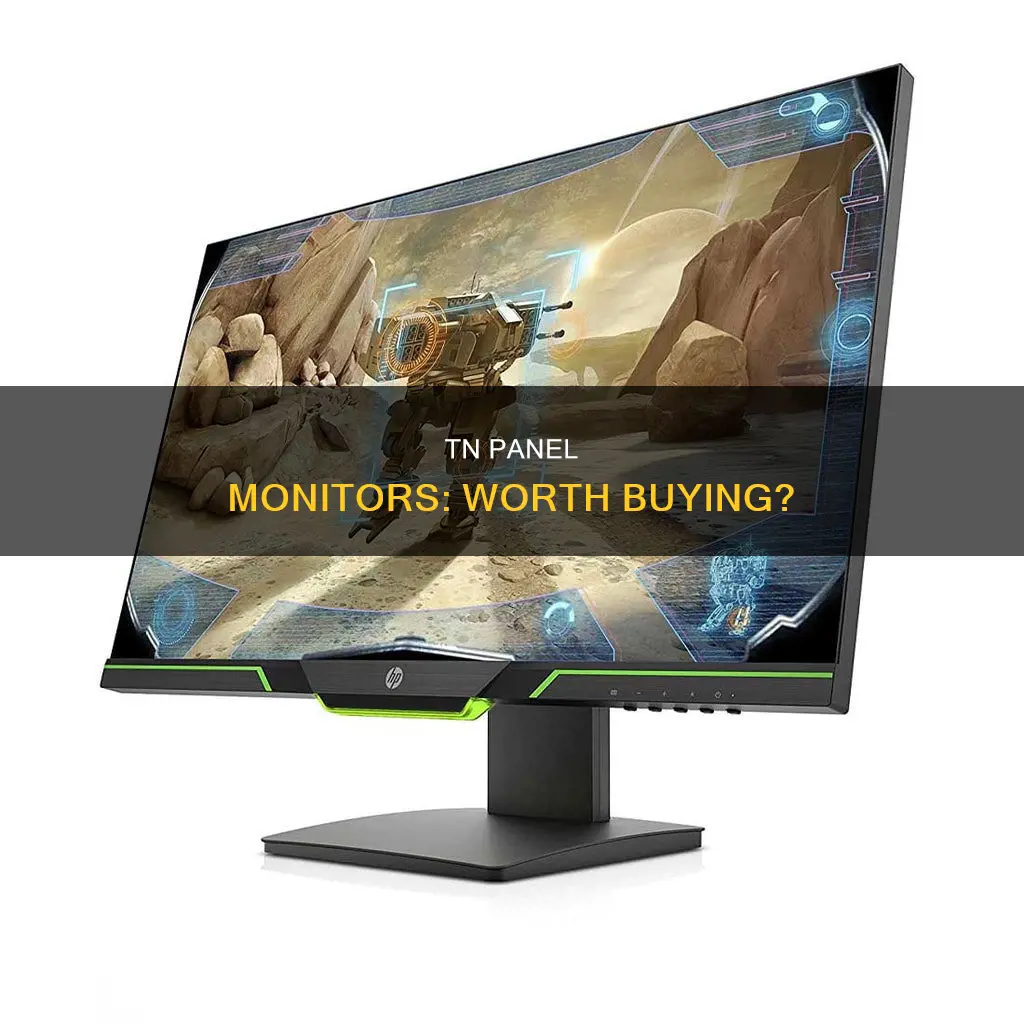
TN panels are twisted-nematic panels, one of the oldest types of LCD screens. They are known for their fast response times and high refresh rates, making them a popular choice for gamers. However, they fall short in terms of colour accuracy and viewing angles. TN panels are more affordable than IPS (in-plane switching) panels, which offer superior colour accuracy and wider viewing angles. TN panels are a good choice for gamers who want the highest frame rate possible and are on a budget. IPS panels, on the other hand, are ideal for those who want to experience games as intended by the artists, with accurate and consistent colours.
| Characteristics | Values |
|---|---|
| Type | Twisted Nematic (TN) |
| Image Quality | Poor colour accuracy and viewing angles |
| Response Time | Fast |
| Refresh Rate | High |
| Cost | Affordable |
| Use Cases | Competitive gaming |
What You'll Learn

TN panels' advantages and disadvantages
TN panels, or Twisted Nematic panels, are the oldest type of LCD panels. They are popular for their fast response times and high refresh rates, making them a favourite among gamers. They are also more affordable than other panels such as IPS (In-Plane Switching) and VA (Vertical Alignment) panels. However, TN panels fall short when it comes to colour accuracy and viewing angles.
Advantages:
- Fast response times and high refresh rates: TN panels offer very low input lag, making them appealing for gamers. They can support refresh rates of up to 240Hz, which is ideal for fast-paced gaming environments.
- Affordable: TN panels are cheaper to produce, which makes them more affordable for consumers. This is especially beneficial for those on a budget or who want to prioritise other specs for their monitor setup.
- Low power consumption: TN panels do not require a current flow to operate and run under low operating voltages, resulting in low power consumption. This makes them suitable for low-powered devices such as digital watches and calculators.
Disadvantages:
- Poor colour accuracy and viewing angles: TN panels have a limited viewing angle, and users need to look at the panel straight-on to fully appreciate the colour accuracy. When viewed from other angles, colours appear dull and images look darker, with noticeable colour shifts and image distortion.
- Variability in quality: The quality of TN panels can vary depending on the manufacturer. Lower-end panels may exhibit more extreme colour shifts when the viewing angle changes, even slightly. Images on these lower-quality panels can also be indiscernible when viewed under direct sunlight due to poor colour reproduction and low-powered backlighting.
In conclusion, TN panels can be a good choice for those who prioritise response times and refresh rates, especially gamers or those on a budget. However, they may not be ideal for those who require accurate colour reproduction and wider viewing angles, such as professionals in graphic design or video editing.
ELMB ASUS Monitors: How Does It Work?
You may want to see also

TN panels' suitability for gaming
TN panels are a popular choice for gaming monitors due to their fast response times and high refresh rates. These features are advantageous for competitive gaming, where quick reactions and smooth visuals are crucial. However, TN panels have drawbacks in colour accuracy and viewing angles when compared to other panel types like IPS (In-Plane Switching) and VA (Vertical Alignment).
TN panels offer lower colour accuracy and narrower viewing angles. Colours may appear distorted when viewed from different angles, and they can only display 262,144 colours, compared to the 16.7 million colours that IPS panels can produce. This limitation can result in colour banding, affecting the overall visual quality.
However, TN panels excel in response times and refresh rates. A faster response time ensures sharper images and reduces motion blur, which is essential for fast-paced gaming. Higher refresh rates, measured in Hertz (Hz), provide smoother and more fluid visuals. This combination of high refresh rates and low response times makes TN panels ideal for gamers who prioritise speed and performance over colour accuracy.
While TN panels may not offer the best colour reproduction or viewing angles, they are often more affordable than IPS panels. This makes them a cost-effective option for gamers on a budget or those who primarily use their monitors for gaming and less colour-critical tasks.
In summary, TN panels are well-suited for gaming due to their fast response times and high refresh rates. They are a popular choice among competitive gamers who require quick reactions and smooth visuals. However, they fall short in colour accuracy and viewing angles when compared to other panel technologies. Ultimately, the choice between TN and other panel types depends on the specific needs and preferences of the user, balancing performance, features, and cost.
Setting Up 100Hz on Your ASUS ROG Curved Monitor
You may want to see also

TN panels' colour accuracy and viewing angles
TN panels, or Twisted Nematic panels, are known for their fast response times and high refresh rates, which make them a popular choice for gaming monitors. However, they fall short in terms of colour accuracy and viewing angles when compared to IPS panels.
TN panels are only capable of displaying 262,144 colours, which can result in colour banding and a poor viewing experience. They have limited viewing angles, typically as low as 170° horizontally and 160° vertically, and the colours can become distorted when viewed from extreme angles. This makes them unsuitable for colour-critical work, such as graphic design or photography, where accurate colour representation is required.
On the other hand, IPS panels offer superior colour accuracy and can display 16.7 million colours, the maximum number of colours that can be produced by graphics cards. They provide consistent and accurate colour displays, even when viewed from side angles, making them ideal for professionals who require precise colour representation.
While TN panels are responsive and affordable, IPS panels deliver a more immersive viewing experience with their wider viewing angles and accurate colour reproduction. This makes them a preferred choice for professionals in fields like graphic design, photography, and video editing, as well as for casual users who value colour accuracy and viewing comfort.
Exploring the Benefits of Overdrive on ASUS Monitors
You may want to see also

TN panels' durability and lifespan
TN panels, or Twisted Nematic panels, were the first type of LCD panel to be widely produced, and they are still among the most widely used. TN panels have a number of benefits over CRT monitors, including lower weight, lower cost, lower power consumption, thinner profiles, clearer pictures, higher resolutions, and the ability to eliminate flicker. However, TN panels have suffered from limited viewing angles, uneven backlighting, motion blur, higher input lag, and poor display in sunlight.
In terms of durability and lifespan, TN panels have a similar lifespan to other types of LCD monitors, which typically range from 30,000 to 60,000 hours of use. This equates to approximately 10 to 20 years of use if the monitor is used for eight hours a day. However, it's important to note that the brightness of the backlight will decrease over time, and the monitor may need to be replaced or repaired once it reaches the end of its lifespan. Additionally, factors such as usage, temperature, and brightness can affect the lifespan of a TN panel, with higher temperatures and brightness reducing the lifespan.
To extend the lifespan of a TN panel, it is recommended to adjust the brightness to a comfortable level and turn off the screen when not in use. Additionally, it is important to follow the operating conditions suggested by the manufacturer, avoid physical damage, and ensure that connections and cables are secure.
HP V212 Monitor: Know the Exact Dimensions
You may want to see also

TN panels' cost compared to other panels
TN panels are Twisted Nematic panels, a type of LCD (Liquid Crystal Display) that has been widely used in monitors for several decades. They are known for their fast response times, high refresh rates, and superior brightness. However, they fall short when it comes to colour accuracy and viewing angles. TN panels are often chosen for their affordability and rapid response times.
In terms of cost, TN panels are generally more affordable than other panel types such as IPS (In-Plane Switching) and VA (Vertical Alignment). IPS panels offer superior colour reproduction and wider viewing angles, but they tend to be more expensive. VA panels provide excellent contrast ratios and are good multi-purpose displays, but they can be more costly than TN panels.
For example, a 27-inch TN panel with a 144Hz refresh rate can be found for around $300, while a similar IPS panel may cost upwards of $500. TN panels are typically less expensive due to their simpler manufacturing process. This makes them a popular choice for budget-conscious consumers who require fast response times.
When deciding between TN and other panel types, it's important to consider your specific needs and budget. If you require accurate colour reproduction and wide viewing angles, IPS panels are ideal. If you need high contrast ratios, VA panels are a good option. However, if you prioritise fast response times and affordability, TN panels are a suitable choice.
Is Your Android Hacked? Signs to Look Out For
You may want to see also







